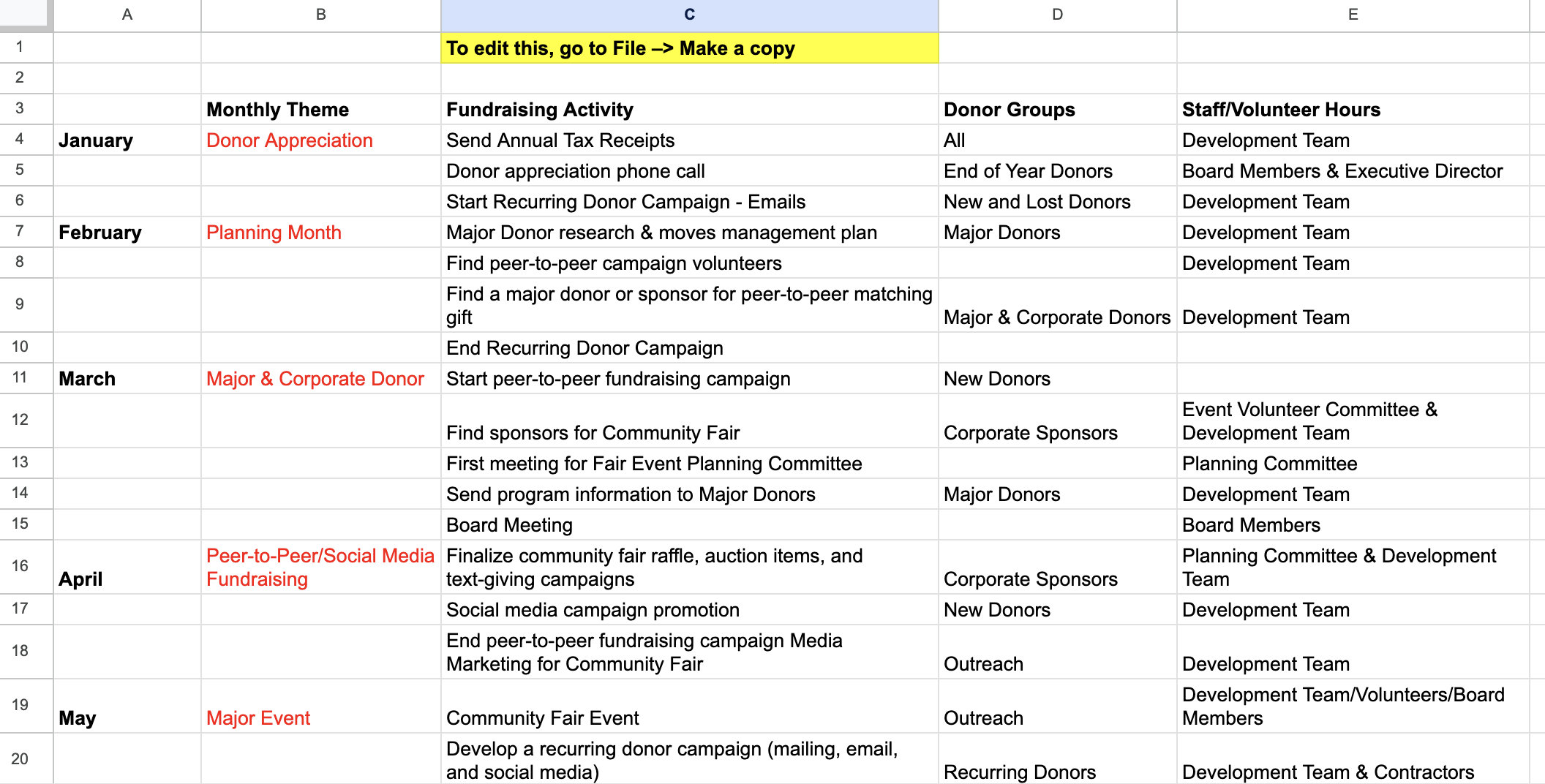Fundraising can feel like you’re jumping on every trend. It’s far too common to spend time holding events and sending out mail or online campaigns without seeing a significant return on your investment. Fundraising calendars are meant to help your nonprofit plan out the year ahead of time and keep on track.
Calendars also outline donor communications, campaign timelines, special events, and other critical dates. Calendars help fundraisers plan outreach to each donor group. The following article gives tips on how to develop your fundraising calendar and provides a template for you to use.
How to Develop and Maintain A Fundraising Calendar for Nonprofits

All nonprofit fundraising calendars should include fundraising activities, dates, departments, and costs involved. Laying out your plan in calendar form lets you see how much time, money, and support you’re giving yourself to meet your goals. It is essential to finalize your fundraising calendar at least one month before your fundraising begins. This gives your fundraising team time to get approval from your Board of Directors and plan logistics to help carry out your plans.
It is best to use past years to decide on events and estimated costs and income when developing your fundraising calendar. The following tips will help determine the best times to fundraise and what actions to include.
- Determine the Best Times to Ask for Gifts
- Add Specific Dates
- Breakdown Actions for Each Campaign
- Create Monthly Plans and Themes
1. Determine the Best Times to Ask for Gifts
The end of the year is often the best time to fundraise. People tend to be more generous during the holidays and look for unique ways to give donations as gifts. Even after Christmas, nonprofits can encourage people to give before December 31st to get a tax break the following year. Once this season is over, your nonprofit may want to use January and February for planning and donor outreach instead of adding another fundraising campaign or event.
For some nonprofits, the end-of-year campaign is secondary to another popular fundraising season, Ramadan. Since the date of Ramadan is different every year, it is best to add these campaign dates to your fundraising calendar first.
After these campaigns, the best times for fundraising depend on the organization. While some nonprofits may have noticed their donors leave for vacations during the summer and have difficulty fundraising during these months, other organizations may hold their largest events during the summer season and bring in significant amounts. When developing your calendar, look at past budgets and events to determine the best times to ask for gifts.
2. Add Specific Dates
Every nonprofit has a few special events that have been successful in the past, and they want to continue. These special events should be the first things added to your fundraising calendar. After your special events, it is time to add other fundraising campaigns. There are times throughout the year when you can add campaigns to recruit recurring donors or hold peer-to-peer online campaigns. Online campaigns can be an excellent way to fundraise during slower months. Here’s an example.

After special events and campaigns, board and budget meetings can take time and effort. It is vital you add these dates to your fundraising calendar as well. A significant benefit to adding board meetings to your fundraising calendar is getting a better idea of when and how you can encourage board involvement in your fundraising efforts.
Pro tip: If you have a board meeting scheduled the same month as you plan to reach out for event sponsors or call major donors, your fundraising calendar is a helpful reminder to get them involved.
3. Breakdown Actions for Each Campaign

Special events and fundraising campaigns are more than just one date. When adding these actions to your fundraising calendar, it is important to include all fundraising actions to get a realistic idea of how much time and money is spent.
3.1 Special events
After adding a special event to your calendar, include the following actions:
- First event planning committee meeting
- Volunteer onboarding
- Sponsor recruitment
- Finding auction items
- Donor wealth research and segmentation
- Mailing invitations
- Marketing efforts
- Donor thank-you efforts
You will also want to add outreach efforts for donors during these events. Your donors want to feel special and appreciated by the organization, so it is critical to find unique ways to reach out to these individuals. You should have your Board of Directors call major donors to invite them to the event or personally thank them for their gift. You should also send personalized invitations to all your donors.
3.2 Fundraising campaigns
Fundraising campaigns must include the start and end dates, but also the following fundraising actions as to when –
- To design and print fundraising appeals
- Mail fundraising appeals
- Send out emails
- Add social media posts for your campaign
- Send out updates (emails, posts, on fundraising page)
- Send tax receipts
- Mail surveys or send feedback emails
3.3 Peer-to-peer and crowdfunding campaigns
The pandemic has changed the way nonprofits fundraise, and many nonprofits have added crowdfunding or peer-to-peer campaigns (example in the below image) as part of fundraising campaigns.

Including peer-to-peer fundraising in your campaign can help the organization reach more people, turn supporters into advocates, and bring in more funds. But it will also take more time and effort. To better plan for these fundraising efforts, nonprofits need to add recruiting volunteers, training fundraisers, and sending information to your fundraisers to add to their own calendars as well.
4. Create Monthly Plans and Themes

Events and Campaigns take a lot of time, but they are not the only fundraising and marketing options available for nonprofits. Fundraising calendars help nonprofits determine the best times to reach out to major donors, personally, thank donors, appreciate volunteers, and market to a larger audience.
When creating your fundraising calendar, it is an excellent idea to create a theme or action for each month. Months that include a special event won’t include other efforts, but if your events occur in May and September, that leaves ten more months to focus on major donor outreach, donor acknowledgments, and volunteer appreciation.
Sample Fundraising Calendar
Now that you have a better idea of what to add to your fundraising calendar, we want to share a sample fundraising calendar to help you get started. The sample here includes monthly themes, fundraising activities, donor groups, staff and volunteer involvement, cost, and estimated income. You can create your own copy to edit by going to “File” and clicking “Make a copy.”

Over to You

A fundraising calendar will make a huge difference in your fundraising efforts throughout the year. It will make your nonprofit more systematic, organized, and well-prepared in every situation. You will notice a drastic change in the way you handle snags in fundraising. Your strategies will improve with time. There will seldom be a time when you’ll fall short of volunteers or staff or time before a big event starts. Eventually, this will strengthen your donors’ trust and give you a sense of comfort in the days to come.
If your nonprofit is looking for ways to fundraise online, Donorbox is here to help! After you create your fundraising calendar, visit our website for a list of features that can help you raise more funds online. We help nonprofits with recurring donation forms, free donation pages, peer-to-peer fundraising, crowdfunding, text-to-give, membership campaigns, and more.
Do check out the rest of our blog for fundraising ideas, tips, and nonprofit management insights.

![How to Create and Maintain a Fundraising Calendar [+ Free Sample]](https://donorbox.org/nonprofit-blog/wp-content/uploads/2022/02/2022-JanFeb-2-1.png)









